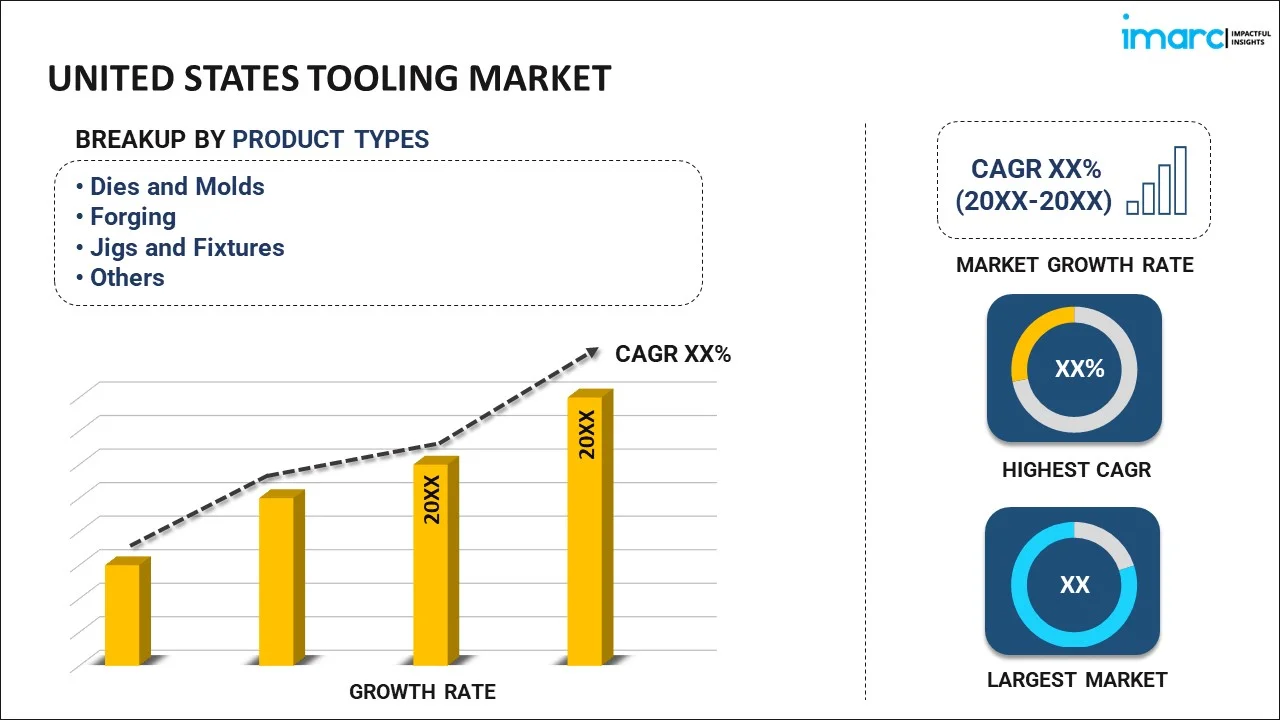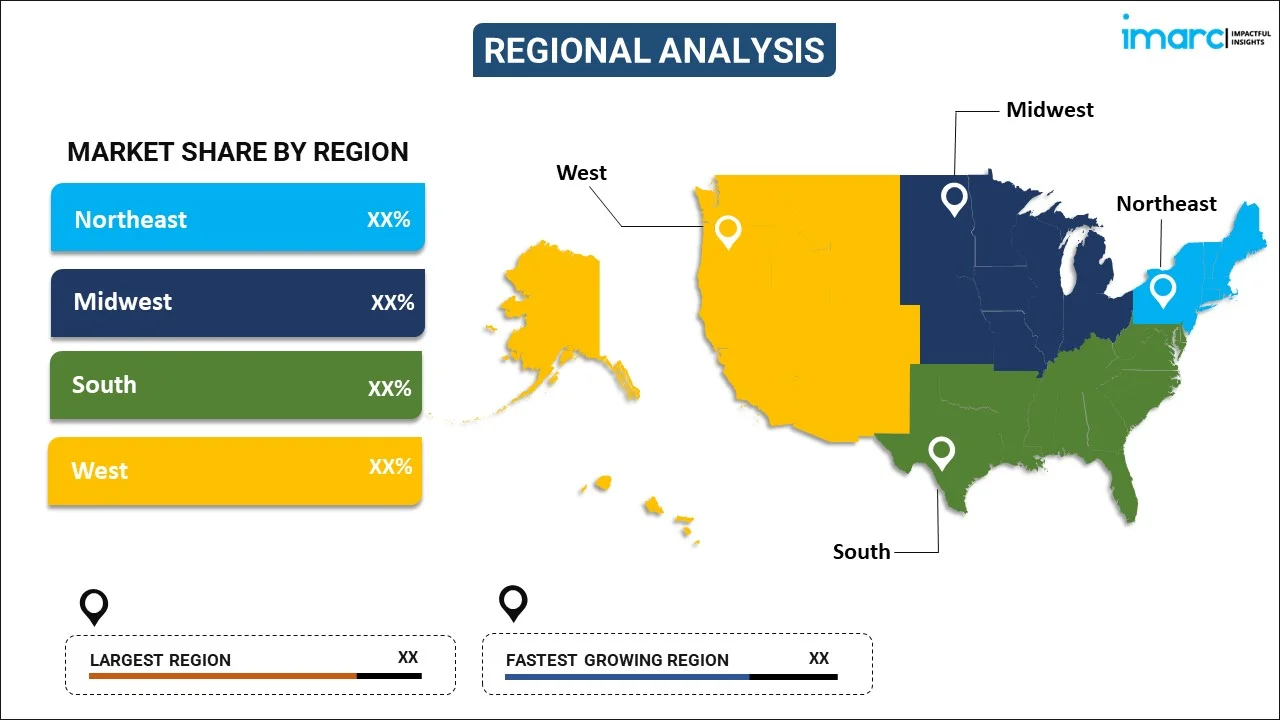
United States Tooling Market Report by Product Type (Dies and Molds, Forging, Jigs and Fixtures, Machines Tools, Gauges), Material Type (Stainless Steel, Iron, Aluminum, and Others), End Use Industry (Automotive, Electronics and Electrical, Aerospace, Marine and Defense, Plastics Industry, Construction and Mining, and Others), and Region 2025-2033
Market Overview:
The United States tooling market size reached USD 48.7 Billion in 2024. Looking forward, IMARC Group expects the market to reach USD 80.2 Billion by 2033, exhibiting a growth rate (CAGR) of 5.2% during 2025-2033. The rising need for sophisticated and durable tools to cater to the growing demand for precision-engineered components, the augmenting demand for building critical components with complex geometries compliant to stringent quality requirements, and the rising trend of micro-manufacturing represent some of the key factors driving the market.
|
Report Attribute
|
Key Statistics
|
|---|---|
|
Base Year
|
2024 |
|
Forecast Years
|
2025-2033
|
|
Historical Years
|
2019-2024
|
| Market Size in 2024 | USD 48.7 Billion |
| Market Forecast in 2033 | USD 80.2 Billion |
| Market Growth Rate (2025-2033) | 5.2% |
Tooling refers to the process of designing and engineering the tools that are necessary to manufacture parts or components. It includes a broad array of devices and equipment such as cutting tools, fixtures, molds, dies, jigs, gauges, and other tools that are used to shape raw materials into parts and products. These tools are specifically designed and engineered to carry out various manufacturing processes such as cutting, drilling, milling, turning, molding, stamping, forging, casting, and more. Tooling devices are typically characterized by their durability, precision, and capability to withstand rigorous conditions. They are designed to work under high pressure, heat, and speed. Tooling devices are often custom-made to suit specific manufacturing needs, ensuring that each tool fits its purpose perfectly. Tooling devices are made from a range of materials, including high-speed steel, carbide, ceramics, polycrystalline diamond, and more. These materials are chosen based on their hardness, toughness, wear resistance, and heat resistance. The use of proper tooling in manufacturing processes offers several advantages, such as increasing the efficiency and speed of the production process, improving productivity, higher quality end-products, and mass production of components with complex geometries.
United States Tooling Market Trends:
The market in the United States is majorly driven by the rising need for sophisticated and durable tools to cater to the growing demand for precision-engineered components. In line with this, an enhanced focus on reducing production times and improving efficiency is resulting in a higher product uptake in the manufacturing sector. Additionally, the augmenting demand for building critical components with complex geometries compliant to stringent quality requirements in the aerospace and automotive sectors is fueling the market. Besides this, the rising trend of micro-manufacturing due to the advent of device miniaturization in numerous end-use industries is also driving the demand for innovative and precise tooling. With industries adopting advanced materials for production, they also require advanced tooling capable of handling these materials, thereby contributing to the growth of the market. Moreover, the emergence of technologies such as additive manufacturing, 3D printing, and artificial intelligence (AI) are creating lucrative opportunities in the tooling market. Furthermore, the key players in the market are investing in training programs for skilled labor, which is creating a positive outlook for the market. Apart from this, the rise in infrastructure development and construction sectors augmenting the demand for heavy machinery and equipment are further stimulating the market. Some of the other factors contributing to the market include increased spending in the military and defense sector, continual technological advancements in the electronics and electrical sector, and rapid industrialization.
United States Tooling Market Segmentation:
IMARC Group provides an analysis of the key trends in each segment of the United States tooling market report, along with forecasts at the country level for 2025-2033. Our report has categorized the market based on product type, material type and end use industry.
Product Type Insights:

- Dies and Molds
- Forging
- Jigs and Fixtures
- Machines Tools
- Gauges
The report has provided a detailed breakup and analysis of the market based on the product type. This includes dies and molds, forging, jigs and fixtures, machines tools, and gauges.
Material Type Insights:
- Stainless Steel
- Iron
- Aluminum
- Others
A detailed breakup and analysis of the market based on the material type has also been provided in the report. This includes stainless steel, iron, aluminum, and others.
End Use Industry Insights:
- Automotive
- Electronics and Electrical
- Aerospace, Marine and Defense
- Plastics Industry
- Construction and Mining
- Others
A detailed breakup and analysis of the market based on the end use industry has also been provided in the report. This includes automotive, electronics and electrical, aerospace, marine and defense, plastics industry, construction and mining, and others.
Regional Insights:

- Northeast
- Midwest
- South
- West
The report has also provided a comprehensive analysis of all the major regional markets, which include Northeast, Midwest, South, and West.
Competitive Landscape:
The report has also provided a comprehensive analysis of the competitive landscape in the United States tooling market. Competitive analysis such as market structure, key player positioning, top winning strategies, competitive dashboard, and company evaluation quadrant has been covered in the report. Also, detailed profiles of all major companies have been provided.
United States Tooling Market Report Scope:
| Report Features | Details |
|---|---|
| Base Year of the Analysis | 2024 |
| Historical Period | 2019-2024 |
| Forecast Period | 2025-2033 |
| Units | Billion USD |
| Scope of the Report | Exploration of Historical and Forecast Trends, Industry Catalysts and Challenges, Segment-Wise Historical and Predictive Market Assessment:
|
| Product Types Covered | Dies and Molds, Forging, Jigs and Fixtures, Machines Tools, Gauges |
| Material Types Covered | Stainless Steel, Iron, Aluminum, Others |
| End Use Industries Covered | Automotive, Electronics and Electrical, Aerospace, Marine and Defense, Plastics Industry, Construction and Mining, Others |
| Regions Covered | Northeast, Midwest, South, West. |
| Customization Scope | 10% Free Customization |
| Post-Sale Analyst Support | 10-12 Weeks |
| Delivery Format | PDF and Excel through Email (We can also provide the editable version of the report in PPT/Word format on special request) |
Key Questions Answered in This Report:
- How has the United States tooling market performed so far and how will it perform in the coming years?
- What has been the impact of COVID-19 on the United States tooling market?
- What is the breakup of the United States tooling market on the basis of product type?
- What is the breakup of the United States tooling market on the basis of material type?
- What is the breakup of the United States tooling market on the basis of end use industry?
- What are the various stages in the value chain of the United States tooling market?
- What are the key driving factors and challenges in the United States tooling market?
- What is the structure of the United States tooling market and who are the key players?
- What is the degree of competition in the United States tooling market?
Key Benefits for Stakeholders:
- IMARC’s report offers a comprehensive quantitative analysis of various market segments, historical and current market trends, market forecasts, and dynamics of the United States tooling market from 2019-2033.
- The research study provides the latest information on the market drivers, challenges, and opportunities in the United States tooling market.
- Porter's five forces analysis assist stakeholders in assessing the impact of new entrants, competitive rivalry, supplier power, buyer power, and the threat of substitution. It helps stakeholders to analyze the level of competition within the United States tooling market industry and its attractiveness.
- Competitive landscape allows stakeholders to understand their competitive environment and provides an insight into the current positions of key players in the market.
Need more help?
- Speak to our experienced analysts for insights on the current market scenarios.
- Include additional segments and countries to customize the report as per your requirement.
- Gain an unparalleled competitive advantage in your domain by understanding how to utilize the report and positively impacting your operations and revenue.
- For further assistance, please connect with our analysts.
 Inquire Before Buying
Inquire Before Buying
 Speak to an Analyst
Speak to an Analyst
 Request Brochure
Request Brochure
 Request Customization
Request Customization




.webp)




.webp)












